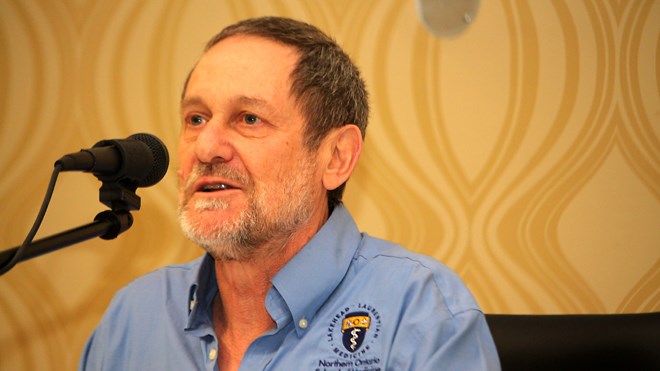Before the Northern Ontario School of Medicine (NOSM) was established in 2005, it was difficult for many communities in the North to attract and retain physicians.
“So many people were without a family doctor,” said Dr. Roger Strasser, the school's dean. “Access to care in the hospital was very tough.”
As NOSM celebrates its tenth anniversary, Strasser highlighted many of the school's successes during a luncheon organized by the Greater Sudbury Chamber of Commerce on Nov. 18.
“In 10 short years, we've come a long way,” he told the lunch-time crowd.
Since 2008, the City of Greater Sudbury has recruited 67 family physicians, of which 59 graduated from NOSM.
The school's approach from the start, said Strasser, was the train northerners, who would then be more likely to practice here.
In fact, 92 per cent of NOSM's medical doctor students are from Northern Ontario, and the remaining eight per cent are from remote and rural communities in the rest of Canada.
Ninety-four per cent of students who did their residency through the school have decided to practice medicine somewhere in Northern Ontario, and 22 per cent of them have chosen to work in smaller communities.
Dr. Liane Villano was one of those students. She recently completed her residency with NOSM, and opened a new family medicine practice in Espanola this year.
Villano grew up in Sudbury, and graduated from high school in 2004; one year before NOSM was established at the campuses of Laurentian and Lakehead universities, in Sudbury and Thunder Bay.
She had always wanted to be a doctor, but thought she would need to leave Northern Ontario for her training.
“I knew I wanted to work in Northern Ontario, in a smaller community,” she said.
Once NOSM was established, it quickly became Villano's first choice for medical school.
But due to the competitive nature of medical school, and the very high standards required for acceptance, she had to apply twice before she landed a spot in first-year.
In her later years, she got to do placements in smaller communities, and did six months of her residency in Espanola.
The experience allowed her to treat a wide range of patients, without relying on other physicians as much to find solutions for their problems.
“As a family doctor, you have a bigger role and you're doing a lot more things that you wouldn't get to do living in an urban centre,” she said.
Thanks to young physicians like Villano, smaller communities are now better served than they have been in years.
Chapleau, for instance, did not have a family physicians for seven years.
But in 2012, three NOSM graduates established a family practice in the small community.
“For those seven years, the doctors were only dealing with urgent, acute cases,” said Strasser. “Now, since the three physicians have been there, they've put in place a whole system of preventive care and health promotion that's actually improving the health of the people.”
With a new five-year strategic plan, Strasse said he hopes the school can continue its mission to improve the health of northerners.
The school plans to strengthen its health research, for example, by establishing masters and PhD programs through the school for medical sciences.
Join Sudbury.com+
- Messages
- Post a Listing
- Your Listings
- Your Profile
- Your Subscriptions
- Your Likes
- Your Business
- Support Local News
- Payment History
Sudbury.com+ members
Already a +member?
Not a +member?
Sign up for a Sudbury.com+ account for instant access to upcoming contests, local offers, auctions and so much more.
